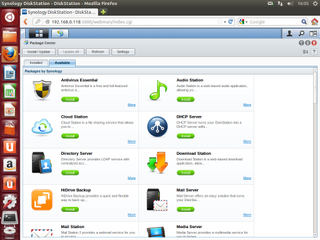It isn't until the DSM software is installed and the system rebooted that you'll can correct a major oversight by Synology: the default wireless settings feature no encryption whatsoever. If you've followed the instructions and connected your DS213air to the network, the system will allow anybody with a wireless device access to your entire infrastructure until the WPA2 encryption setting is toggled and a password set.
That minor niggle aside, the DS213air is incredibly easy to configure. As with previous Synology products, the DSM software - which works through a web browser and provides a desktop-like icon-based interface - is intuitive, and the new wireless features of the DS213air configurable by selecting one of three pre-configured roles: gateway, access point or client.
Usage
Using the DS213air as a simple file storage device is easy enough, with the system supporting Windows, OS X and Linux clients out of the box. A little poking around in the settings allows for other features to be enabled, including private cloud access over the internet and support for Apple's Time Machine backup format - a major plus if your network is heavy with OS X-based devices.
The DSM software can do a lot more than that, however. A Package Centre allows the installation of Synology-provided and third-party packages that turn any DSM-running product into a fully-fledged server. From the Package Centre, it's possible to install software that adds virtual private network support, turns the system into a voice over IP server, or even provides courseware functionality through the popular open-source Moodle project.

It's here where the corners cut for the DS213air start to become apparent. Synology's high-end devices, which pack up to 12 drive bays, include significantly more memory than the 256MB allotted to the DS213air - and if you start to pile on the features by installing more and more packages through the Package Centre, you'll soon find the DS213air start to chug.
It almost seems unfair to pick on the DS213air for this, though: it is a NAS unit, after all, and not sold as a server. At 250, however, it's roughly the same price as HP's Turion-based ProLiant microserver - and actually more expensive if you take advantage of HP's long-running 100 cashback offer. With the ProLiant offering 2GB of DDR3 RAM, a similar processor and more drive bays - plus coming with a 250GB drive bundled - it seems strange that Synology couldn't budget for an extra bit of memory to boost the DS213air's performance.
Verdict
It's easy to mark the Synology DS213air down for its high price, especially when compared to rival devices like the HP ProLiant microserver. To do so is to ignore the benefits of Synology's DSM operating system. While it's certainly possible to configure any Linux-based server in a similar way, it's a lot easier to set things up using DSM - and if you would rather spend your time using your NAS server than configuring it, that could be easily worth the entry fee.
OS: Synology DiskStation Manager (DSM) 4.0 (Linux-based) Processor: Intel Atom 1.6GHz Memory: 256MB DDR3 Capacity: Up to 8TB across two SATA II bays Connectivity: Gigabit Ethernet / 802.11b/g/n Wi-Fi (2.4GHz only) Expansion: 2x USB 3.0 'SuperSpeed' Size: 165 x 100 x 225.5mm Weight : 0.94kg
Gareth Halfacree is an experienced tech journalist and IT professional, and has been writing since 2006. In addition to contributing article for ITPro, Gareth has been featured in publications such as PC Pro, Techmeme, The Register, The MagPi, and Tom’s Hardware.
In addition to his digital articles, Gareth is the author of several best-selling books. These include the Raspberry Pi User Guide, an essential text for those looking to get started with their Raspberry Pi, as well as The Official Raspberry Pi Beginner’s Guide. Gareth also wrote the Official BBC micro:bit User Guide, a comprehensive guide to setting up the pocket-sized computer, learning to code on it, and even creating your own hardware addons.

